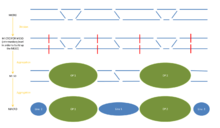RailTopoModel
RailTopoModel is a systemic model for describing the topology-based railway infrastructure as needed by various applications. The RailTopoModel has been developed under patronage of the International Union of Railways (UIC) and will be released as International Railway Standard (IRS) 30100.[1]
Motivation
In the field of railway networks, many non-standard descriptions are needed for addressing specific needs: RINF to describe infrastructure; ETCS for train control and protection; INSPIRE for spatial information. Network operators or suppliers took particular initiatives to harmonize their network representations for gathering, providing, or using network-related data. The purpose of RailTopoModel is to define a general, standard model.
History
The development of the RailTopoModel is a result of the ERIM project (abbreviation for European Rail Infrastructure Modelling) within UIC that aims at standardized data representation and exchange concerning railway networks.[2]
In 2013, starting from the assessment of a small group of IMs about limitation of current exchange formats for ETCS, RINF, Inspire, and European projects based on network topology, the UIC ERIM feasibility study[3][4] was launched. The objective of this working group was to qualify the business needs, analyze the existing solutions and experiences, and propose a project plan to build a universal “language” to improve the railway data exchange, and support the design of an infrastructure data exchange format based on topology. Based on this study a topology model, the ‘UIC RailTopoModel’, was developed. In April 2015 RTM V1.0 was released.[5] ‘UIC RailTopoModel’ shall become a UIC recommendation called International Railway Standard (IRS 30100)[6] in spring 2016.
railML.org, a European open source initiaitve providing a standard for data exchange in railway networks since 2001, will offer the first use case for RailTopoModel through a new version of its infrastructure schema, railML3.
Structure


RailTopoModel is based on connexity graph theory and it is defined in terms of UML.[5]
Its emphasis lies on:
- Core elements — identification of all network components;
- Referencing — defining standards for addressing locations e.g. via geographical coordinates. The backbone of referencing in RailTopoModel is a linear referencing system;
- Topology — expressing the relations between the elements;
- Business — allowing to project objects and events onto the topology. These can be spots (e.g. a signal), linear entities ( e.g. a tunnel) or areas (e.g. a train station);
- Aggregation — allowing for the standardized and reversible aggregation e.g. to visualize the network in a broader scale. There are four predefined aggregation levels:
- nano: very large scale, depicting e.g. the interior of a switch
- micro: large scale, depicting e.g. switches and buffer stops connected by tracks
- meso: intermediate scale, depicting e.g. operation points and the number of tracks connecting them
- macro: small scale, depicting main operation points and the corridors between them
- The model allows defining as many levels as is deemed useful, while ensuring consistency of data between levels.
Ideally, standardisation should grant for references and switches between aggregation levels being bijective and different applications being able to exchange data.
Applications
Current applications are:
- railML: the topology core of railML's scheme version 3 will be defined on the basis of RailTopoModel.
- Ariane model as foundation of all SNCF Réseau IT projects: the definition of Ariane model at SNCF Réseau employs the same concept: it combines a connexity graph (for the topology of the network) with an object approach to define a systemic model of the railway system. The principal benefit of this approach is to distinguish between the business object of the system and the processes that manage them. Moreover, it allows for an evolutive and understanding model. This type of modeling is needed to build a virtual railway system to simulate all processes.
External links
- http://www.railtopomodel.org/ — project website
- http://documents.railml.org/science/270415_uic_railtopomodel_v1-0.pdf — current version
References
- ↑ "The development of the new railML 3 schema - railML.org (en)". railml.org. Retrieved 2015-10-20.
- ↑ "UIC e-news 362: The foundation for a Universal Infrastructure Data Exchange Format". November 30, 2014.
- ↑ trafIT solutions (September 2013). "Feasibility Study UIC RailTopoModel and data exchange format" (PDF). Zurich, Switzerland.
- ↑ "Feasibility Study — RailTopoModel" (PDF). documents.railml.org. Retrieved 2015-10-20.
- 1 2 "RailTopoModel — Railway Network Description — A conceptual model to describe a railway network" (PDF). documents.railml.org. Retrieved 2015-10-20.
- ↑ UIC Paris and railML.org (April 28, 2015). "4th UIC RailTopoModel and railML Conference: Governanceby" (PDF).